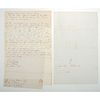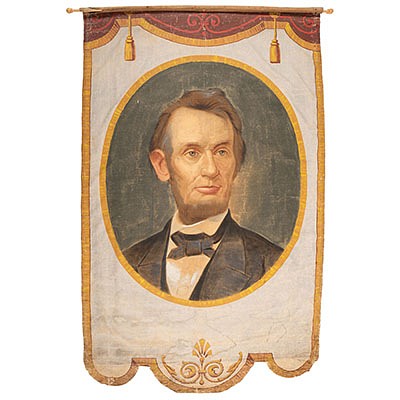[NATIVE AMERICANS] -- [PEQUOT]. A group of manuscript ledgers. 1836-1874
About Seller
6270 Este Ave.
Cincinnati , OH 45232
United States
With offices in Cincinnati, Cleveland and Denver, Cowan’s holds over 40 auctions each year, with annual sales exceeding $16M. We reach buyers around the globe, and take pride in our reputation for integrity, customer service and great results. A full-service house, Cowan’s Auctions specializes in Am...Read more
Two ways to bid:
- Leave a max absentee bid and the platform will bid on your behalf up to your maximum bid during the live auction.
- Bid live during the auction and your bids will be submitted real-time to the auctioneer.
Bid Increments
| Price | Bid Increment |
|---|---|
| $0 | $25 |
| $500 | $50 |
| $1,000 | $100 |
| $2,000 | $250 |
| $5,000 | $500 |
| $10,000 | $1,000 |
| $20,000 | $2,500 |
| $50,000 | $5,000 |
| $100,000 | $10,000 |
About Auction
Jun 25, 2021
The June 25 American Historical Ephemera and Photography Auction features an exciting assemblage of 18th-early 20th century material, including Civil War archives, Early Photography, Western Americana, Autographs and Manuscripts, and more. Cowan's Auctions dawnie@cowans.com
- Lot Description
Lot of 4, two sets of ledger pages and two petitions to the Superior Court of Connecticut.
Mohegans and Pequots were formerly one group, indigenous to the Connecticut River Valley for at least a few thousand years. In 1636 some Pequots killed a resident of the Connecticut Colony and war erupted. The Mohegan and Narrangansett sided with the colonists. Of the 3000 or so Pequots who had survived a 1633 epidemic, an estimated 1500 were killed in the Pequot War, either in battles or hunted down and captured or killed. Shortly after the war Connecticut established two reservations, one in North Stonington (Eastern Pequot Reservation) and one in Ledyard (Western or Mashantucket Pequots). Most tribal members live in these two communities even today. By the 1910 census, the population numbered 66, and continued to decline for a few decades. Pequot numbers did not increase dramatically until the 1960s though 1980s.
In 1976 the Pequots (especially Mashantuckets) filed suit against the residents of North Stonington to get their land back, which they claimed was illegally sold in 1856 by the State of Connecticut. “Mashantucket Pequot Indian Land Claims Settlement Act” was passed by Congress and signed by Ronald Reagan in Oct 1983 granting federal recognition to the Mashantucket tribe. In 1986 they opened a bingo operation followed by a casino in 1992.
Eastern Pequots were recognized in 2002. Two groups of Eastern Pequots agreed to unite to achieve federal recognition This was challenged by the state and the BIA revoked their recognition in 2005. It also revoked the recognition of the Schaghticoke tribe, another Connecticut group, who had just gained recognition the previous year. It is thought that they did this because the state was afraid federally recognized groups would open more casinos.
The earliest item in this group is a document dated April 1, 1856 addressed to the Superior Court of the state of Connecticut. 8 x 12.5 in. "We the undersigned are composed of the real members of the Groton Pequot Indian Tribe and we present this petition before your Hon hoping that you will hear our complaints and we humbly [beg] the favour of the Hon. Court to answer our request against the sale of the Pequot reservation also against all sales and deeds being given of the said reservation by William M Mo[r]gan or any other person or Persons because it is against our best interest our future welfare also against the constitution of the United States of America and against our own consent for our names were not on the Petition that was car[r]ied into the Legislature of the Stat[e] of Connecticut for a grant to sell said land of the Pequot reservation neither were we duly notified. Please search into the validity of our request, your humble petitioners would ever pray." Followed by four marks and names of members of the tribe.
Attached to this is a smaller sheet, 6 x 8.5 in. dated Feb. 8, 1856. This letter echoes the first and is from members of the Pequot tribe residing in the town of Ledyard and "heirs to the Pequot reservation." This is followed by a list of 22 more names (most X's with the members' names written beside them). This is likely the land sale referenced in 1976.
The second Court document is similar to the first, dated 28 March 1874, 7 3/8 x 12 1/4 in.. Again they are asking the court to stop the sale of lands belonging to the tribe. They also request that Leonard C. Williams of Stonington be removed as overseer of the tribe and be replaced by Dudley H. Stewart, Esq. of North Stonington. In the end, they cannot part with the lands "our Fathers and Mothers and Brothers and Sisters Wifes and Children were buried it is dear to us for God Sake stop it." Signed by six more tribal members. (written in pencil and very light)
Ledger of Pequot Indians with debts to Ezra Hewitt, Apr. 1, 1836 to Apr. 1, 1837. One sheet 16 x 13 in., folded to 8 x 13 in. These items include fabric (calico), candles, shoes, an ax, sugar molasses, a shawl, rice, corn, codfish and more. Their remaining debt was just over $10.
The second ledger is 12 pages (plus 8 blank), 7.75 x 12.5 in. These date from Apr. 1, 1872 to Apr. 1, 1873, and are recorded by individual rather than the entire tribe - Amasa Lawrence, Lyman Lawrence, Jane Lawrence, Eliza Niles, Jane Potter, and others. These seem to be more foodstuffs, such as porK, flour, meal, potatoes, molasses, beans, turnips, fish, beef, butter, but still includes cloth, candles and other items. The ledger is signed by Seth Main, the overseer of the Ledyard Pequots. - Shipping Info
-
SHIPPING & PICKUPS Cowan’s Cincinnati Office offers an in-house, full-service shipping department which is unparalleled in the auction industry. Shipping costs are provided with your finalized invoice 24-48 hours after auction. For furniture and oversized items, we recommend using third-party services. For more information, contact cowansshipping@hindmanauctions.com. NOTE: All pickups and preview are by appointment only. To make an appointment, please call 513-871-1670 or email cincinnati@hindmanauctions.com Buyers are required to pay for all packing, shipping and insurance charges. Overseas duty charges are the responsibility of the successful Bidder. Be aware that for larger and/or valuable items, shipping charges can be substantial. - Shipping charges include insurance for your order while in transit. If you have private insurance we will adjust your charge to include only packing and shipping. - Please allow 14 – 21 days after payment to package and ship your purchase as carefully as possible.
-
- Buyer's Premium



 EUR
EUR CAD
CAD AUD
AUD GBP
GBP MXN
MXN HKD
HKD CNY
CNY MYR
MYR SEK
SEK SGD
SGD CHF
CHF THB
THB![[NATIVE AMERICANS] -- [PEQUOT]. A group of manuscript ledgers. 1836-1874](https://s1.img.bidsquare.com/item/l/8590/8590513.jpeg?t=1LMYtO)
![[NATIVE AMERICANS] -- [PEQUOT]. A group of manuscript ledgers. 1836-1874](https://s1.img.bidsquare.com/item/s/8590/8590513.jpeg?t=1LMYtO)











